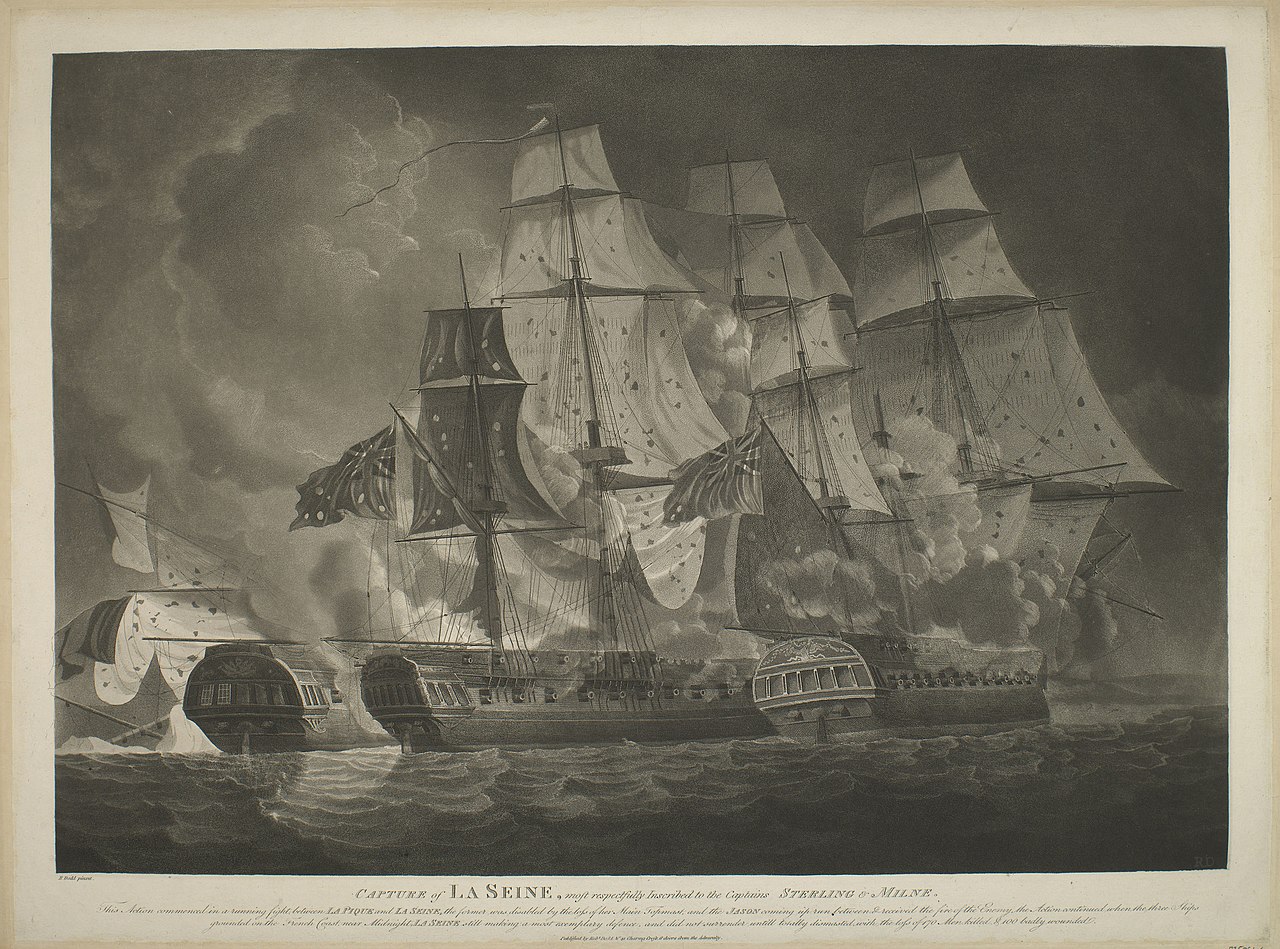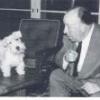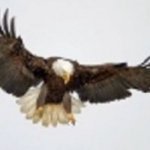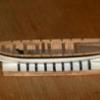HOLIDAY DONATION DRIVE - SUPPORT MSW - DO YOUR PART TO KEEP THIS GREAT FORUM GOING! (Only 13 donations so far - C'mon guys!)
×
-
Posts
2,249 -
Joined
-
Last visited
Reputation Activity
-
 Beef Wellington reacted to Mike_H in HMS Snake by Mike_H - FINISHED - Caldercraft - 1:64
Beef Wellington reacted to Mike_H in HMS Snake by Mike_H - FINISHED - Caldercraft - 1:64
Bowsprit and Jib Boom
The bowsprit was remarkably fiddly, but gave lots of learning so I'm reasonably pleased.
The bowsprit requires 13 cleats and a bee to be placed reasonably carefully. This I did by machining shallow slots using my Proxxon mill. I took the photos below after I had fitted the cleats, but the slot for the bee is visible. The square tenon to take the cap can also be seen. Machining that was relatively straightforward though the undercut on the top surface was a tittle tricky
Far more tricky was the cap itself. As has been remarked before, the kit-provided part with two circular holes bored perpendicular to the surface is virtually useless. In the picture below, on the LHS you can see what happens when you machine a square slot for the tenon - it is not possible to fit the square slot around the circular hole (I did the geometry - but I'll spare you that). On the RHS is the cap I scratch built. Easy to machine, hard to design, so here's my sketch of the cross-section - crucial to that was determining the angle of the bowsprit (19º above horizontal), and the width of the jib boom seating bracket (2 mm).
Here it is assembled (with interim gammoning around the boom)
Bumkins added
Painted and rigged - with Petrejus's "hour glass" gammoning.
-
 Beef Wellington reacted to BANYAN in HMCSS Victoria 1855 by BANYAN - 1:72
Beef Wellington reacted to BANYAN in HMCSS Victoria 1855 by BANYAN - 1:72
John, having looked at your idea of a Spanish Burton, which I had not even considered, if all three blocks are used this would work if a 'purchase winch' was used. However, the Rigging Warrant lists 4 x 10" and 2 x 9" SINGLE blocks, which suggests two guntackle purchases, with perhaps each being tailed with a runner (whip)? Here is a workable configuration for a 'Spanish burton' arrangement for the gin blocks (which will have alternated between Port and Stbd for the fore and main masts). Still need to bite the bullet and go by the Rigging Warrant listing or by the Contract Specification - the correspondence is silent on this, and unfortunately the imagery does not show either configuration. The following (and previous post) is looking from the front.
Thanks again John
Pat
-
 Beef Wellington reacted to BANYAN in HMCSS Victoria 1855 by BANYAN - 1:72
Beef Wellington reacted to BANYAN in HMCSS Victoria 1855 by BANYAN - 1:72
Hi guys, a small bit of progress - see below a piccy of the PE for the tops - the fold line will enable me to create the angle-iron trestrees and the after ends of the rim for the 'D" fore rims. I will need to attach the rest of the rim front, and drill out for the various eyebolts (start holes already etched).
I am also back to the Tyes and Purchases/Halliards again. Having progressed to other things, I revisited this and realised I had got it all wrong and need to sort out the topsail tyes again.
Here is the predicament - the Specification called for the fitting of Purchase winches for the topsail yard. The correspondence from the ship build superintendent (that I have been able to access so far) is silent on them. As this person was very detailed and informative in his very regular reports, it is unlikely he will have neglected to inform if these had been omitted.
The Rigging Warrant does not mention them but does offer a very complex arrangement that does not align with the arrangements described by any of the contemporary or more modern authors consulted. The Rigging Warrant
lists the tye for the fore topsail as 68’ of 9/16” chain with “Gin on Yard and 2 Hanging Gins Iron”. It also lists a halliard associated with the fore topsail tye, made up from 27 fathoms of 2½” hemp rope, associated with four 10”, and two 9” single blocks, and two travellers under the ‘Thimbles’ column.
The only way such a list of items could be configured (as far as I can determine) is for the gins to set up as shown in the following image (I drew up in CAD). The tails of the chain have long links for the associated halliards. As two traveller thimbles + 4 by singles blocks suggests two separate halliards. Halliards were normally a pendant set-up to the port channel (for the foremast) and the purchase to starboard. The only arrangement I can determine here is that two separate up-and-down halliards with a runner (whip) was used?
Any other ideas guys?
cheers
Pat
-
 Beef Wellington reacted to Bitao in NAIAD 1797 by Bitao - 1:60
Beef Wellington reacted to Bitao in NAIAD 1797 by Bitao - 1:60
It took me a day to get the whole thing polished and corrected. The construction of the inner parts can begin later. Thank you for your support and attention.
-

-
 Beef Wellington reacted to Sjors in HMS Victory by Sjors - Caldercraft - 1:72
Beef Wellington reacted to Sjors in HMS Victory by Sjors - Caldercraft - 1:72
Then a little update.
All the bulwarks and stripes and more of that funny stuf is on it.
Painted and happy.
Last saturday we had a model meeting in the Netherlands from a Dutch forum.
They helped me with the black stripes because they don't follow the bulwarks.
So now I am happy 🙂
-
 Beef Wellington reacted to Sjors in HMS Victory by Sjors - Caldercraft - 1:72
Beef Wellington reacted to Sjors in HMS Victory by Sjors - Caldercraft - 1:72
Little impression of the day.
Also a builder ( Jan Zwart ) has make the Victory inside - out.
Every deck has his own drader with all the figures in it.
It's amazing to see and watch.
-
 Beef Wellington reacted to Kevin in HMS Enterprise by Kevin - CAF - 1/48 - August 2020
Beef Wellington reacted to Kevin in HMS Enterprise by Kevin - CAF - 1/48 - August 2020
just arrived today the replacement upper deck about a week from China, Thank you Tom @cafmodel
-
 Beef Wellington got a reaction from Martin W in HMS Bellerophon by flyer - FINISHED - Amati/Victory Models - scale 1:72
Beef Wellington got a reaction from Martin W in HMS Bellerophon by flyer - FINISHED - Amati/Victory Models - scale 1:72
Nice work Peter, I found the rigging and configuration of the martingale to be one of the harder things to figure out, even with Lees as as reference, so glad you have a plan.
-
 Beef Wellington got a reaction from sziggy8 in HMS Ballahoo by sziggy8 - Caldercraft - 1/64 scale - First Ever Build
Beef Wellington got a reaction from sziggy8 in HMS Ballahoo by sziggy8 - Caldercraft - 1/64 scale - First Ever Build
Hi Sziggy, not sure which paint you'll be using, but assuming it will be some sort of acrylic. You seem to have masked off the deck pretty well, worst case scenario is you get a couple of areas bleeding through, but this can be easily scraped off gently using the sharp end of a scalpel blade once dry and no-one will be any the wiser (at least that has been my experience with the Admiralty acrylics). Applying multiple, thin layers will help lower the risk of bleed as well as give you a better finish. Something to consider for next time is to simply paint the lower plank prior to installation and then you don't have to deal with it, above a small amount of touch up where you don't need to worry too much about perfect masking.
-
 Beef Wellington reacted to dunnock in HMS Diana by dunnock - FINISHED - Caldercraft - 1:64
Beef Wellington reacted to dunnock in HMS Diana by dunnock - FINISHED - Caldercraft - 1:64
Thanks for all the likes, it really does help to keep me going.
I have been wondering how to add the name Diana to the upper counter. I wasn’t keen on using the pe brass letters supplied as they looked a bit too chunky, so I pondered on how to either paint or apply my own lettering in some way. Having searched through all the typefaces on Windows, I decided that like others before me, Perpetua Titling looked the most appropriate. I would probably make a mess if I attempted to paint it freehand. I tried printing on baking sheet and transferring onto the model as suggested by Rob in his Jason log but the result was too faint for me to see. In the end I cut the letters out and stuck them on. The result looks effective from normal viewing distance but one leg of the N still looks a bit shaky even after tidying up. I think that if I try to improve on it, I will probably make it worse so I’m going to leave well alone.
Now it was time to bite the bullet and get the stern galleries fixed. I glazed the stern lights using the kit PET film. The two false lights were glazed separately and the central section in one piece. The false lights are backed with black card in the same way as the false quarter lights.
All lined up ready to glue:
And fixed in place with the taffarel and upper counter
With the stern gallery in place I was able to carry out a final adjustments to the quarter galleries. I was disappointed to find that some of the components required more than a little fettling, but I’m now happy with the way they look and I have glued them in place. A lot of painting and repair work to do before the final decoration and mouldings are added but I’m confident that it will look fine when complete.
I now have a couple of problems with the final decoration. One of the console brackets ( I think that they are supposed to be stylised dolphins) is badly formed so I have written to Caldercraft asking for a replacement. The other is that I have broken one of the swags that go on the top piece of the quarter gallery. The mouldings as supplied are very chunky, so I filed them back to the bare swag. Unfortunately I was not careful enough and broke one of them. I hope that I can align it when I fix it in place.
Once work on the stern is finished, I will move on to fitting the rudder which I have already started coppering.
-
 Beef Wellington got a reaction from Egilman in WARATAH 1902 by ccoyle - FINISHED - HMV - 1/250 - CARD - Steam Tug
Beef Wellington got a reaction from Egilman in WARATAH 1902 by ccoyle - FINISHED - HMV - 1/250 - CARD - Steam Tug
I suspect Chris is referring to the fact that the deck droops in between the bulkheads so there is no clean deck sheer line...looks like the prominent ribs on a starving cow's body.
-
 Beef Wellington got a reaction from Old Collingwood in WARATAH 1902 by ccoyle - FINISHED - HMV - 1/250 - CARD - Steam Tug
Beef Wellington got a reaction from Old Collingwood in WARATAH 1902 by ccoyle - FINISHED - HMV - 1/250 - CARD - Steam Tug
I suspect Chris is referring to the fact that the deck droops in between the bulkheads so there is no clean deck sheer line...looks like the prominent ribs on a starving cow's body.
-
 Beef Wellington got a reaction from thibaultron in WARATAH 1902 by ccoyle - FINISHED - HMV - 1/250 - CARD - Steam Tug
Beef Wellington got a reaction from thibaultron in WARATAH 1902 by ccoyle - FINISHED - HMV - 1/250 - CARD - Steam Tug
I suspect Chris is referring to the fact that the deck droops in between the bulkheads so there is no clean deck sheer line...looks like the prominent ribs on a starving cow's body.
-
 Beef Wellington got a reaction from Richard44 in WARATAH 1902 by ccoyle - FINISHED - HMV - 1/250 - CARD - Steam Tug
Beef Wellington got a reaction from Richard44 in WARATAH 1902 by ccoyle - FINISHED - HMV - 1/250 - CARD - Steam Tug
I suspect Chris is referring to the fact that the deck droops in between the bulkheads so there is no clean deck sheer line...looks like the prominent ribs on a starving cow's body.
-
 Beef Wellington got a reaction from mtaylor in WARATAH 1902 by ccoyle - FINISHED - HMV - 1/250 - CARD - Steam Tug
Beef Wellington got a reaction from mtaylor in WARATAH 1902 by ccoyle - FINISHED - HMV - 1/250 - CARD - Steam Tug
I suspect Chris is referring to the fact that the deck droops in between the bulkheads so there is no clean deck sheer line...looks like the prominent ribs on a starving cow's body.
-
 Beef Wellington got a reaction from ccoyle in WARATAH 1902 by ccoyle - FINISHED - HMV - 1/250 - CARD - Steam Tug
Beef Wellington got a reaction from ccoyle in WARATAH 1902 by ccoyle - FINISHED - HMV - 1/250 - CARD - Steam Tug
I suspect Chris is referring to the fact that the deck droops in between the bulkheads so there is no clean deck sheer line...looks like the prominent ribs on a starving cow's body.
-
 Beef Wellington got a reaction from Canute in WARATAH 1902 by ccoyle - FINISHED - HMV - 1/250 - CARD - Steam Tug
Beef Wellington got a reaction from Canute in WARATAH 1902 by ccoyle - FINISHED - HMV - 1/250 - CARD - Steam Tug
I suspect Chris is referring to the fact that the deck droops in between the bulkheads so there is no clean deck sheer line...looks like the prominent ribs on a starving cow's body.
-
 Beef Wellington reacted to ccoyle in WARATAH 1902 by ccoyle - FINISHED - HMV - 1/250 - CARD - Steam Tug
Beef Wellington reacted to ccoyle in WARATAH 1902 by ccoyle - FINISHED - HMV - 1/250 - CARD - Steam Tug
It's not just the difficulty of the kits by themselves, but rather a combination of factors. As I said, I purchased the PE brass detail set to use with Maine. HMV was not yet offering laser-cut card detail sets at the time, so PE brass or, in some cases, nickel-silver were the only options -- or just to use the card parts provided in the kit. I don't like PE metal parts all that much, though I know that they work wonders for plastic kit builders. I don't like the prep work, the painting, and the meticulous folding that is required, even if the final results do look awesome. I much prefer the laser-cut card sets. The Maine kit also had a number of small but niggling design issues, such as coloring that didn't match up on adjacent parts and vague positioning of some parts in the diagrams. Neither of those is a deal-breaker by itself, but I just kind of lost interest in the kit, and it hasn't come back yet. Maybe it will at some point, but I don't make a habit of working on kits I'm not enthused about in the moment. BTW, the Maine kit is no longer available from HMV, which means it might be undergoing a revision, which would be both good and bad. Good, because a revised kit with a laser-cut detail set would be awesome (I love pre-Dreadnoughts), but bad because that would probably kill off any residual desire to finish the current iteration!
Emden is a sad story. I started building her as part of a book project, but I really should have chosen a less ambitious subject -- Emden is rated sehr schwierig (very difficult), and the rating is thoroughly deserved. The book project died (sorry, Bob) for several reasons, one being that I had talked Danny Vadas into working on the project with me, and he subsequently was unable to contribute as he would have liked due to his deteriorating health; I was depending on him for writing the material on rigging, which is a real weakness in my skill set, and Emden has a lot of rigging. I also lost most of the early in-progress construction photos thanks to computers dying and my penchant for packing up and moving every few years, including a cross-country move smack in the middle of construction. The final nail in the coffin might not seem like a big deal, but it was the laser-cut railings for the forecastle; the diagrams did not present their locations clearly, they did not fit correctly, and I ended up damaging them while attempting to mount them on the model, a construction failure for which their is no easy fix. If you damage a part on a wood model, you simply make yourself a new part; you can't really make a new laser-cut railing. I also discovered that the present location of the bridge superstructure will interfere with the placement of the foremast. So, add those all together -- the long build time, the difficulty of the model, the momentum for the book project waning, and the significant obstacles to completing the model after so much effort had already gone into it -- and it drained away any remaining build mojo.
So, there you have the whole story. One final thing I will say about the Emden tropo version kit (HMV also offer the same kit in gray) is that upper works color is really much closer to straight-up orange than to buff. I don't know if the actual color used by the German Navy was that shade or not, but it is a little off-putting on the model.
I do have the HMV SMS Undine kit in my stash, with both PE and laser-cut card detail sets for it. Undine was a Gazelle-class cruiser, very similar in design, layout, and armament to Emden, so if I ever feel up to the challenge someday, she may yet wind up on the workbench.
-
 Beef Wellington reacted to ccoyle in WARATAH 1902 by ccoyle - FINISHED - HMV - 1/250 - CARD - Steam Tug
Beef Wellington reacted to ccoyle in WARATAH 1902 by ccoyle - FINISHED - HMV - 1/250 - CARD - Steam Tug
Nautical art by Doris be like:
Nautical art by Chris be like:
-
 Beef Wellington reacted to ccoyle in WARATAH 1902 by ccoyle - FINISHED - HMV - 1/250 - CARD - Steam Tug
Beef Wellington reacted to ccoyle in WARATAH 1902 by ccoyle - FINISHED - HMV - 1/250 - CARD - Steam Tug
The last 24 hours have been a trying time for the construction of poor Waratah. First of all, I had to double some rather large parts (including the deck in last night's photo -- this actually happened prior to the previous post), so I went to the garage to give them a shot of 3M 77. When I came back to my man cave, the AC kicked on, which flipped one corner of the paper towel I was carrying sticky parts on. The deck and some other parts landed sticky sides together. 🤬 Happily, I was able to get everything apart without too much obvious damage. Then, I left my desk for several hours, and when I came back the deck had warped significantly. So I did my best to straighten it out and then left it under the glass sheet overnight.
Fast-forward to today. Once I got the deck glued down, I was treated to the dreaded STARVING COW look. 🤬 I still haven't figured out how to defeat this particular card modeling nemesis. So I spent most of the day cutting spacers from bits of scrap plywood veneer and using those to shore up the sagging areas. I now have the run of the deck edges sufficiently straightened, to my eye, and am ready to tackle the hull sides. That task will require some trial fitting to see if I need to remove bulkhead material anywhere.
One unintended side effect of building such a small model is that simply cropping a photo of the hull properly results in something like an enlargement. Hmm.
-
 Beef Wellington reacted to Mike_H in HMS Snake by Mike_H - FINISHED - Caldercraft - 1:64
Beef Wellington reacted to Mike_H in HMS Snake by Mike_H - FINISHED - Caldercraft - 1:64
Seems I've not been on here for a while. That's mainly because I retired from work a month ago, but the Admiral only retired this week. That gave me a month to get back on my bike and do some ship building, but not much appetite to sit at a computer and update this build log.
So here's the update - all five components of the masts are built, painted and installed, and all the lower deadeyes are in place. I found the deadeyes quite frustrating as the metal loops they sit in were tricky to handle - opening them out to insert the deadeye always distorted them, so closing them back up again usually messed up the little loop in which the chain sits. I closed up the channels using some epoxy putty, which not only makes things seems stronger, it hides the mangled metalwork. Anyway, I got there in the end. Making the masts was reasonably straightforward with the usual mix of patience and tolerance of imperfections.
Very glad I bought the Proxxon mill and lathe. The mill makes machining the square sections of the masts very easy and I even made the heels of the upper masts octagonal. That was a little tricky with 4 mm dowel, but once I bodged up a tailstock from the lathe to use on the mill, it worked ok
Bowsprit next then perhaps some shrouds, and then the spars. Or maybe a mix of the two.
-
 Beef Wellington reacted to yvesvidal in HMS Bellona by yvesvidal - FINISHED - CAF Model - 1:48
Beef Wellington reacted to yvesvidal in HMS Bellona by yvesvidal - FINISHED - CAF Model - 1:48
I decided to cut the front part L4 and the stern part L2 and came up with the following. Before cutting L2 below, L4 above:
In the picture below, you can see the L4 modified part and the L4 part from the kit. The modified part will go in the middle and will be sandwiched, creating the deFacto staggering that I was looking for.
Now, I just have to assemble the horizontal section of the keel....
Yves
-
 Beef Wellington reacted to mikegr in USS Langley by RGL - FINISHED - Trumpeter - 1/350 - PLASTIC
Beef Wellington reacted to mikegr in USS Langley by RGL - FINISHED - Trumpeter - 1/350 - PLASTIC
Turbojet?😄
-











